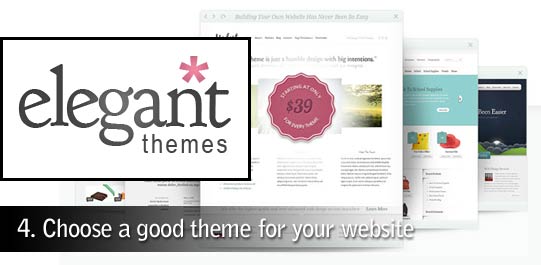How to Plan and Design a Successful Website in 5 Easy Steps
Planning and designing a successful website can feel like a long and complicated process if you’ve never done it before. If you’re just beginning your journey as a website owner, it might seem like it’s going to be a long time before you have a fully functional website.
If you know what you’re doing, however, designing your website doesn’t require as much technical knowledge as you think it might. The key aspects of the process actually revolve around your creativity and planning. I want to help demystify the process behind designing and planning a successful website so I’ve put together a five-step guide that will help you get started.
-
Decide on the purpose and content of your site

This is the most important step for planning and designing a successful website, as it will shape the way your website develops.
Firstly, you need to decide what your website is for. This goes beyond deciding the topic or theme of the the site: you need to think about whether your site is going to be a personal blog, a landing page for a product or person, or a website you eventually want to monetize.
You also need to consider what kind of content you want to host on your website. Are you going to produce a blog, host an online store, or upload a lot of video or audio content?
All these factors will influence the finished product, and decisions you make in the meantime, so now is the time to think about what you want from your site.
You also need to think about the future of your website. The purpose of your website dictates how much money you spend on it, what your measures of success are and how much effort you invest in the site, so it’s crucial to know your priorities as early as possible.
-
Choose a web host and domain name

Once you’ve decided the purpose of your site, you need to choose a web host and a domain name. Your domain name should preferably be the name of your company or brand and, if not, it should be directly related to it. At the same time, it needs to be easy to remember and easy to spell so people who hear about it can find it easily.
NameCheap and GoDaddy are helpful resources for finding and purchasing domain names.
Next you need to find a web hosting package that offers good features at an affordable price. If you are hosting videos and audio, for example a podcast or a Vlog, you’ll need more bandwidth than if you are hosting just HTML pages. You also need enough bandwidth to account for the increase in traffic your website will experience over time. If you bandwidth is capped and the number of visitors exceeded that cap, readers will either experience your site as being incredibly slow, or won’t be able to access it at all.
The kind of service you choose will depend on the type of website you’re running, but research your available options before committing to anything.
We will discuss more on how to find a good web host in future articles. For your reference, the web host that I recommend first and foremost is Bluehost. HostGator, LunarPages and SiteGround are also very good.
-
Choose your CMS and setup your website

Content Management Systems (CMS) make it easier to create new web pages and blog posts, as well as edit existing content. You can choose from a number of popular CMS for your website. One of the most popular is WordPress, many people also use Tumblr, TypePad and Blogger. As WordPress is not only popular but also the CMS I use and recommend to my readers, I will refer to it in the rest of this article. The information I provide will still be relevant and useful for other CMS as well.
Another option to consider is a package host and CMS, such as Weebly. Starting a website with Weebly is completely free. You do not need to pay anything for starting a website on Weebly. Companies like Weebly offer everything you need, including the tools to build and customize your website and hosting, all under one roof!
If your CMS is separate from your host, you will need to set it up on your server. The method for doing so will depend on which host and CMS you are using, so please follow your host’s instructions to install the CMS correctly.
-
Choose a theme for your website

A theme is a ready-made template for your website that changes its appearance. WordPress offers three type of theme: free themes, premium themes and framework themes.
Free themes
Free themes can be helpful when you’re starting out, but they offer limited support, functionality and updates. Therefore, even if you start with a free theme, you will probably need to update it yourself as your website develops.Premium themes
Premium themes cost anything between $15 and $100 and are either available as a single download purchase, or as part of a yearly subscription. My favorite WordPress themes provider is Elegant Themes, who produce professional premium themes for personal as well as business websites.Elegant Themes charge just $69 for access to all the themes in their collection. Currently there are 87 themes, and one to two are being added each month!Framework themes
Framework themes give you more control over the appearance and features of your website, and enable you to design its structure and appearance from scratch, without having to know any coding. We will discuss this type of WordPress themes in more details in future articles.
When choosing a theme, you need to ensure it is appropriate for your website’s purpose. For example, if you’re setting up a business website, your theme needs to fit in with the brand and values of your company. If you have an existing logo, try to find a theme that matches this, as otherwise your website will be more likely to deter people than convert them to paying customers!
Other features to look for in a theme are customization options and documentation. A website theme or template might look pretty but if it doesn’t have all the functions you need, it isn’t going to be much use in the long run. Equally, if a website template looks great and has all the functions you need, but not the documentation that tells you how to use them, that isn’t going to be helpful to you either.
Good quality premium themes, like Elegant Themes, tick all the boxes, providing you with all the features and customization options you need, as well as the support and documentation to help you implement them.
Read more tips on how to choose the best WordPress theme for your website.
-
Customize your website

Now you have setup you website and chosen your theme, you can start tweaking your website so it contains all the features and functionality you want.
WordPress offers widgets, which are portions of code that add extra features to your website (other CMS such as Joomla and Mambo have similar features). These include features like “top commentators”, “image sliders”, “advanced search box” and a list of most recent blog posts. Just like the kind of theme you select, the type of widgets you choose will depend on the features you want on your website.
WordPress users can also make use of plugins, which function behind the scenes to provide extra functionality. These carry out back-end functions, such as filtering comment spam and helping you improve your SEO.
Between widgets and plugins, you’ll be hard pushed to find something that WordPress can’t do. If you’re serious about running a successful website, try to stay up to date with the latest plugin releases, as developers are constantly improving existing code and creating new features!
At the end of this process, you will have a beautiful brand new website. Your next challenges involve creating content and marketing, but right now you can feel proud about the fact you have your very own site up and running.
[…] week, we talked about how you can plan and design a successful website in five easy steps. This week, I’m going to tell you what you can do next once your website […]